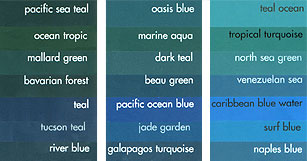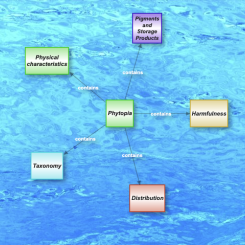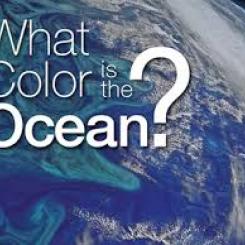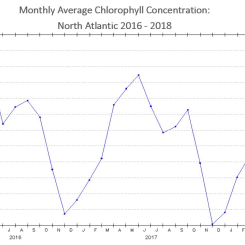Lesson Plans
Phytopia's "Light & Color"
Overview
This lesson is taken from NASA's Phytopia: Discovery of the Marine Ecosystem written in partnership with Bigelow Laboratory for Ocean Science with funding from the National Science Foundation. It illustrates how solar radiation is absorbed and scattered where phytoplankton concentrate and why -- in those turbid areas -- sunlight only penetrates to a shallow depth. Students model light moving through ocean water to observe how light is scattered, reflected, or is absorbed.
Materials Required
- 4 - 6 teaspoons each of two colors of food color ('A' and 'B'; preferably dark blue and dark green)
- 16 oz. liquid antacid (magnesium hydroxide + aluminum hydroxide)
- Four 20 oz. clear plastic drink bottles with twist-on tops (labels removed)
- Two identical shallow baking dishes
- 24 pennies (approx.)
- Duct or masking tape
- Liquids measuring cup
- Teaspoon
- Flashlight
- Disposable gloves (optional)
Procedure
To introduce this activity, you may wish to discuss the concept of the photic zone and its importance to life on Earth. Primary producers that use sunlight to photosynthesize -- and all members of the marine food web -- depend on this sunlit layer. This activity illustrates how solar radiation is absorbed and scattered where phytoplankton concentrate and why -- in those turbid areas -- sunlight only penetrates to a shallow depth.
- Prior to class, put 2 - 3 teaspoons of Dye A into two 20 oz. bottles and the same amount of Dye B into the other two bottles. Twist caps on tightly and label them 'A' and 'B'.
- During class, select four students to help with the demonstration. Ask them to cover the top half of each bottle with tape (i.e., from the middle of the bottle to just below its cap). Have them slowly pour 12 oz. (1.5 cups) of water into each bottle and twist-on cap tightly. Gently swirl the dark liquid within the bottle without inverting the bottle. Ask the class to describe the liquid inside each bottle. (The concentrated dyes will appear black in color.) Can they guess what these liquids might be? (You may find that preparing the liquids and bottles ahead of time is more effective at keeping students 'in the dark' about the bottles' contents.)
- Next, have one of the students with a bottle marked 'A' add 1 cup of liquid antacid to his or her bottle. The other student should slowly add 1 cup of water to his or her bottle 'A'. Those with bottles marked 'B' should do the same. Observe the results.
- Ask the students to explain why they are unable to detect the liquids' color without antacid. (Antacid acts as a scattering agent, without it, light is fully absorbed and not reflected back to the eye.)
- Have two students (who understand that they might get temporary stains on their fingers - or they can wear gloves) to stack 12 pennies in each of two shallow baking pans. They should agree as to whether they wish to work with dye 'A' or 'B'. Have them slowly and carefully pour the bottle without the antacid in one pan and the bottle with antacid in the other pan. (Stacked pennies should protrude above the liquid... if not, add more to each stack and keep track of the total.) Have students shine a flashlight on the liquid without antacid, removing pennies until the submerged ones cannot be seen. How many are left? Just before repeating this process using the liquid with antacid, have students predict whether they'll remove more or fewer pennies and why.
- Shine a flashlight at various angles to explore how light reflects off the surface of the liquid in each pan. (Using a white sheet of paper to 'catch' the reflected light may be helpful.) Does this illustrate how sunlight reflects differently off clear and turbid ocean waters?
Disciplinary Core Ideas:
- LS2A: Interdependent Relationships in Ecosystems
- LS2B: Cycles of Matter and Energy Transfer in Ecosystems
Crosscutting Concepts:
- Cause and Effect
- Systems and System Models
Science and Engineering Practices:
- Planning and Carrying out Investigations
- Create a model to explore how light moves through ocean water
- Observe reflection, scattering, and absorption of light
- Discuss how ocean color depends on scattering and absorption of sunlight
- Consider how sunlight's penetration affects photosynthesis
- Understand the differences between transparent, translucent and opaque liquids
- How do phytoplankton and light interact?
- How do scientists use water properties to measure changes to the Biosphere?
When we look at the ocean from space, we see many different shades of blue. Using instruments that are more sensitive than the human eye, we can measure carefully the wide array of colors of the ocean; and if you think that the ocean is "just blue-green," check out the variety of blue-green colors at your local paint store. From ocean color, we can infer information about phytoplankton populations. Phytoplankton contain various colored pigments such as chlorophyll; thus, ocean color signifies various types and geographic concentrations of phytoplankton.

Primary producers—plant life and ocean phytoplankton—play an integral part of the Earth system; some would say that they drive the entire Biosphere. Plants and plankton influence the composition of the atmosphere, play a part in the water cycle and regulate ocean chemistry. They also provide food for nearly all other life on the planet. And as the above images illustrate, Earth's biosphere is anything but static. Plant growth on land fluctuates with the seasons; so does the blooming of phytoplankton—tiny plant-like organisms in the oceans.
Sunlight penetrates the topmost ocean surface, below that it is always dark. The sunlit top ocean layer is called the photic zone and its depth ranges from a few to hundreds of meters. The bottom of the photic zone is the depth at which the light intensity is about 1% of its intensity at the ocean surface. At any location, the photic zone depth is not constant because of variations in water clarity and daily-to-seasonal changes in the angle of incoming sunlight.
Ocean color is linked to the optical properties of water and how light is absorbed and scattered by dissolved material and suspended particles, including phytoplankton cells. In clear tropical oceans, sunlight penetration is very deep and waters appear indigo blue in color primarily because of the optical properties of water itself. Conversely, the photic zone is shallow where biological productivity is high; in such turbid waters, phytoplankton cells absorb sunlight for photosynthesis while scattering green and yellow light. Ocean color satellites are optimized to detect the range of colors reflected from the ocean surface. Data from these sensors are used to monitor the concentration of chlorophyll -- an indication of phytoplankton concentration -- in the upper ocean.
Ocean color data made available by satellites are also helping to improve our understanding of the ocean's role in the global carbon cycle. The atmosphere is a rich source of carbon dioxide (CO2), as millions of tons of this gas settle into the ocean every year. Phytoplankton use sunlight and CO2 to make food and grow. When they die, their bodies settle to the ocean bottom. Consequently, over geological time, the ocean has become the primary storage sink for atmospheric CO2. About 90 percent of the world's total carbon content has settled to the bottom of the ocean, primarily in the form of dead biomass.
Phytoplankton blooms -- the rapid growth of a phytoplankton population -- are often marked by high concentrations of chlorophyll, a chemical compound crucial for photosynthesis. Knowing the locations of these blooms is very valuable to fishermen and marine biologists, because fish and other marine animals tend to collect near fresh blooms.
Fun "Phyto" Facts:
-
Diameter: < 1 um to over 100 um
If you stack 1000 one micron phytoplankton end to end, the length of the stack would equal the width of a penny! (18,000 would fit across the face)
- Concentration: 1000's to 1,000,000 per milliliter
If you fill a soda can with seawater sampled from a thick, oceanic phytoplankton bloom, the can may contain a many as 75 to 100 million cells! -
Global Phytoplankton Biomass: < 1% of the plant biomass on earth
BUT responsible for nearly half the net photosynthesis of the biosphere!
- General understanding of photosynthesis and marine food webs
- Basic understanding of properties of light
- Phytoplankton are too small to be important—trees win
- Algae (phytoplankton) are plants
THE OCEANOGRAPHY CLASSROOM • 110 Misconceptions About the Ocean
Feller, R.J. 2007. Education: 110 misconceptions about the ocean. Oceanography 20(4):170–173, https://doi.org/10.5670/oceanog.2007.22.
Covering about seventy percent of the Earth's surface, the Oceans are central to the continued existence of life on our planet. The Oceans are where life first appeared on Earth. The largest creatures On Earth (whales) and the smallest (bacteria and viruses) live in the oceans. We rely on the ocean for many things, including food, water transportation, recreation, minerals, and energy. Oceans store energy. When ocean currents change, they cause changes in global weather patterns and can cause droughts, floods, and storms.
However our knowledge of our oceans is limited. Ships, coastlines, and islands provide places from which we can observe, sample, and study small portions of Oceans. But we can only look at a very small part of the global ocean this way. We need a better place from which to study oceans.
Satellites in orbit provide a better than "birds-eye" view of our planet. Because of this perspective, satellites are extremely useful for making large-scale measurements of the ocean. Satellites circling the Earth can survey an entire Ocean in less than an hour. Remote sensing is the term used to describe the process of making measurements from a distance. Remote sensing and in situ ("in place") measurements complement one another. With well-studied localized in situ measurements, scientists can use satellite data to create comprehensive, calibrated models of the ocean environment. Although the cost of building and launching a satellite can be great, the amount of data obtained by such satellites is so vast that the cost of individual data sets is often relatively small. In addition, they provide global coverage which is crucial to understanding the ocean environment. New computer, sensor, and electronic technologies are further reducing the cost of building satellites, and satellite ocean data are expected to become less expensive and even more powerful in the future.
Over the past 50 years, satellites orbiting Earth have unveiled a remarkably dynamic planet. These satellites "look" at clouds to study the weather, or at the sea surface (when it's not cloudy) to measure the sea's surface temperature, wave heights, and direction of waves. Some satellites use radar to "look" through the clouds at the sea surface. One other important characteristic that we can see from space is the color of the ocean. Changes in the color of ocean water over time or across a distance on the surface provide valuable information.
- Molecular and Cellular Biologist - Study cellular molecules and organelles to understand cell function and organization.
- Marine Biologist/Biological Oceanographer - research biological oceanography and the associated fields of chemical, physical, and geological oceanography to understand marine organisms.
- Discuss how your results relate to sunlight penetration, scattering and reflection in the ocean.
- Add a 'control' bottle that has 12 oz. of water and 8 oz. of liquid antacid. Perform Step 4 with this control mixture in one pan and pure water in the other. How does this show you are observing an optical -- not chemical -- phenomenon? Then discuss differences between transparent, translucent and opaque liquids.
- Standalone Lesson (no technology required)





